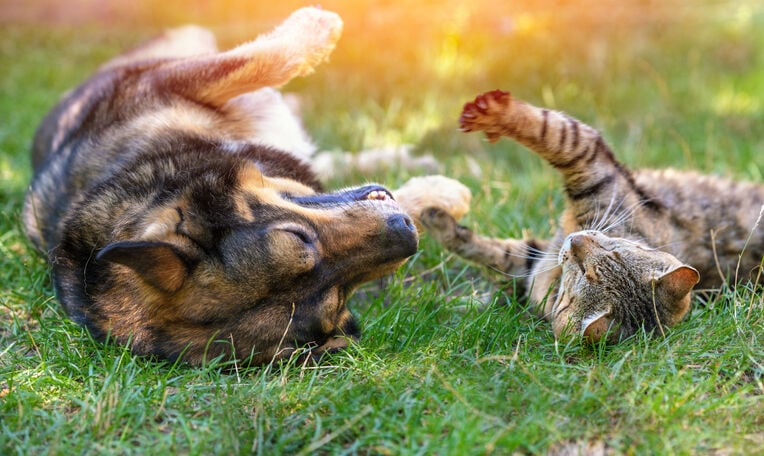We’re not the only ones who enjoy our gardens. Various surveys estimate that about 70% of American households have pets. With that in mind, it’s only natural that we want to have safe outside spaces for our furry family members.
Our climate and ecosystem both add some challenges. Many of our native plants are thorny or spiky, and pose a risk to pets, particularly dogs. Spines and thorns can become embedded in skin or cause damage to eyes. Anyone who has taken a pet to an emergency vet for thorn removal can testify that it’s not a pleasant experience for either the pet or the human. In addition, some of our native critters, such as scorpions and rattlesnakes, can be potentially deadly for our pets. Besides the living threats, our hot temperatures make it necessary for our pets to have constant access to fresh water to keep them from getting dehydrated, particularly if they’re playing outside.
Here are some tips for keeping your Tucson yard safe for pets and usable for the humans in their lives.
- Choose nontoxic plants, particularly if your pet tends to chew on plants. Some dogs (and even cats) tend to try to eat or chew anything in sight. If this is your pet, be especially careful to remove poisonous plants from your yard. If you’re not sure if a plant is safe, check out the ASPCA’s list of both safe and toxic plants for dogs, cats, and horses. In addition, for areas where your pets are likely to be running around, choose non-thorny plants. This will prevent those expensive and distressing vet visits for thorn removal.
- If you have room, provide an area where your pet can run around safely. This is a fenced (ideally walled) area that’s at least 4 feet tall. Various companies offer fencing for snake-proofing your yard if you don’t have a walled area; you can consider doing it yourself by installing hardware cloth fencing all around your yard that’s at least 3 feet tall. Make sure there aren’t any gaps under the fencing or under gates. Also, don’t lean anything up onto walls or fences for snakes to climb. However, any gap, even a small one, will render your “snake-proof” fence useless, so it’s better to get an expert’s guidance. Here’s a great article on how to choose a company and some great general tips on rattlesnake fencing. Also consider signing your dog up for rattlesnake avoidance training.
- If your pet spends a large amount of time outside, make sure they always have fresh, cool water and a shady area to rest. Hardscaping gets very hot, so make sure they can get in and out of the house and to their water and shade without burning their paws. A small mulched area or light-colored gravel path will get less hot in the summer sun. A small pet pool or pond can also help them cool off.
- If you want to have a nice treat for your pets, consider a small grassy area. I don’t normally recommend grass in our climate, as it is a huge water hog, but a few square feet will provide both you and your pets with a nice, cool area and some grass to chew and roll on. Your pet may choose this area as the best spot to do their business, however, so plan accordingly — see below!
- For getting rid of animal waste, consider these options:
- It’s OK to flush dog poop, according to the EPA. Do not flush cat poop as it contains toxoplasmosis, which is not easily removed by our water treatment systems and then infects wildlife (and possibly humans). Also, the litter will likely clog your pipes.
- Getting a poop-removal service. These services usually come once or twice a week to get rid of the poop in your yard. Obviously it requires having a yard that is accessible from the outside.
- Using a mini-septic tank for dog poop like the Doggie Dooley. Note that this will not work for cat poop.
- Putting it in a bag and tossing it in the trash.
- For your feline family members, consider planting catnip in a container. My cats love it, and regularly hang out nearby. It’s quite nice smelling for humans, too. I don’t recommend putting it in the ground, as it can spread and become somewhat invasive (much like mint).
- If you want to go all-out, various pet-related accoutrements can be designed into your yard. Plexiglass windows in the fence, for example, can let your dog look out and see what's going on. Catios, treehouses, and other pet furniture can give your pets more to do in the garden. For smaller pets, like rabbits, external fenced safe areas are vital for their quality of life. Just make sure they have a roof so small animals are protected from the birds of prey that inhabit our neighborhoods.





